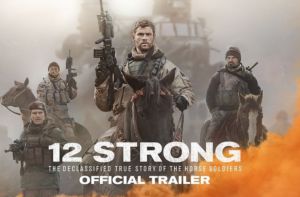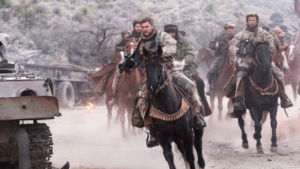Though greatly outnumbered and low on resources, Captain Mitch Nelson (Chris Hemsworth) leads a group of 12 soldiers into some of the most dangerous parts of Afghanistan with intentions to take down the Taliban army. With soldiers fighting ruthlessly to restore peace in Afghanistan, the movie “12 Strong” takes place shortly after the 9/11 attacks on the World Trade Center.
With heavy action scenes, this movie never failed to captivate and engage me. The film not only depicts the struggle to suppress the Al-Qaeda and Taliban forces, but it also demonstrates the extreme willpower and determination of the U.S. soldiers immediately following the infamous terrorist attack. Having to learn unfamiliar war tactics to cope with the rough terrain and combat techniques in Afghanistan, the U.S. rides alongside the Northern Alliance (a united military front in Afghanistan)on horseback for multiple attacks against their enemy. This fast-paced and complicated war style put me in awe as I watched.

The tremendous use of sound effects and music amplified the dramatic scenes throughout the film. With music building up each time combat broke out, it flowed nicely with rhythm of gunfire and stomping of horse hooves. Each intense moment was carried out artistically and with a purpose. For example, before an ambush by the Taliban, there was complete silence other than the footsteps of the U.S. soldiers. It was immediately followed by an overwhelming fusillade of gunfire and shouting. The power of this scene and others like it added to both the overall quality of the movie and its ability to immerse the audience into the film.
As the movie progressed, along with the violent war being fought, “12 Strong” portrayed the group’s ability to build a relationship with troops from the United Islamic front despite an uneasy first impression. Teaming up with the Northern Alliance, tensions were high, and trust was at a minimum.
Though the film did an excellent job showing the strong bond between the Northern Alliance and the U.S. troops, its progression was slow. The high-level uneasiness between the the two groups seemed to fade after only a few scenes. This did seem rather unrealistic, but considering it was already a fairly long film with a runtime of two hours and ten minutes, it was understandable.
Although this film’s main focus was to portray the brutality of the war and intense decisions made by the soldiers, it also incorporated the ability of the soldiers to stay confident during these dark times. This was shown through the use of comical remarks. For example, one of the soldiers had a humorous freindship with a boy who viewed him as a role model, providing relief amid the seriousness of the plot. As the boy shadowed the soldier Ben Milo (Trevante Rhodes), Milo would make entertaining comments to other soldiers about how bothersome the boy would be. Scenes such as this didn’t distract from the movie, but shed some light on how the soldiers likely got through these tough times.

Aside from the lighter scenes, the film showed how each soldier grew as an individual every time they faced with an obstacle. For instance, although the army was reluctant to put in Captain Mitch Nelson of the Special Forces team because lack of experience, he proved that he had the grit and determination to effectively lead his team to success. There was doubt that Nelson could handle such a serious mission because he had never been in live combat before. However, after the first day in the field, he proved that he could lead his team in real life scenarios, as well as training. These individual quests added on to the overall plot of the movie, giving it good background and extra detail.
Main actors Chris Hemsworth and Navid Negahban also accurately depicted the stress of military captains, adding to to the quality of the film production. With each advancement made towards the enemy, the optimism, as well as fear for the safety of their team could be seen through the emotion in their voice. Considering every decision was either critical to the outcome of the war or dependent on their lives, facial expressions and tone were essential to help portray this.
Through engaging cutscenes and interesting camera angles, “12 Strong” had more than just a good story line. While watching, I would sometimes be startled because of how real it felt. Especially during the initial helicopter scene where the turbulence and commotion felt so intense and realistic.
The overarching theme of “12 Strong” was extremely powerful and moving. Along with the well-developed storyline, the quality production brought the film together and made it cohesive and entertaining.







